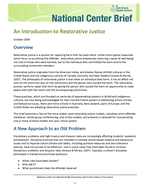An Introduction to Restorative Justice

Restorative justice is a process for repairing harm that has been done. Unlike more typical responses, which focus on punishing the offender, restorative justice emphasizes restoring a sense of well-being not only to those who were harmed, but to the individual who committed the harm and to the surrounding community members.
Restorative justice originates from the American Indian and Alaskan Native (AI/AN) cultures in the United States and the indigenous cultures of Canada, Australia, and New Zealand (Graves & Mirsky, 2007). The philosophy of restorative justice is that when an individual does harm, it has an effect not only on the victim but also on the community and the person who caused the harm. The restorative process works to repair that harm by giving the person who caused the harm an opportunity to make peace with both the victim and the encompassing community.
These practices, which are founded on centuries of peacemaking systems in AI/AN and indigenous cultures, are now being acknowledged for their transformative powers in addressing school climate and behavioral issues. More and more schools in Australia, New Zealand, parts of Europe, and the United States are adopting restorative justice practices.
This brief examines a few of the more widely used restorative justice models, including victim-offender mediation, family group conferencing, and circles models, and presents a rationale for incorporating one or more of these models into your school system.
Download An Introduction to Restorative Justice from the National Center for Mental Health Promotion and Youth Violence Prevention.
